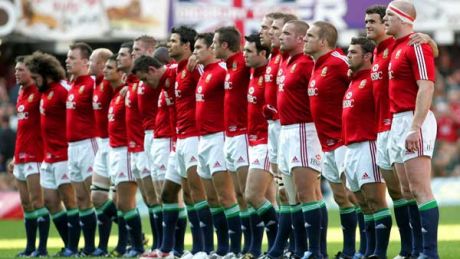
Tom Wood, Flanker, On Endurance
“Rowing is my favourite way of improving fitness at the moment. I’m a bit of a sadist with it. I’ll do 500m as fast as I can for one flat-out rep. My record is 1.14min – at the end I fell off the machine.
“Another way to get a cardio workout from weights is to do dumbbell complexes. Choose a weight you can do eight reps with and work for eight minutes on front raises, rear delt flyes, shoulder press, flat bench press and finish with Turkish sit-ups [sit-ups on a bench holding the weights straight above you]. Do it in pairs so you complete all the exercises without putting the weights down and then rest while the other is working. It’s a great way to boost your cardio, especially if you can’t run too much because of injury.”
Billy Twelvetrees, Centre, On Motivation
“At my club Gloucester we do Olympic lifting and variations with power and hang cleans to develop our game. Rugby is such an intense sport and you only get milliseconds to make decisions so the explosiveness we can develop in the gym really helps us capitalise on the pitch.
“The sprinters are naturally powerful, able to power clean about 120kg. I’m around that mark but some of the forwards will be lifting really heavy weights.
“Every week we’re setting new targets competing against team-mates who play in the same position and that competition is good in the gym because it really brings the best out of you.
“You should also identify your specific goals and train to help you achieve them rather than just lifting weights with no target in mind. My focus to succeed on the pitch motivates me in the gym.”
Dan Cole, Prop, On Muscle Mass
“We spend such a long time out on the field but that’s not conducive to maintaining weight and muscle mass. Hydration is key and if you’re training seriously hard a high-calorie diet helps, but so it’s also worth finding time after training to do a little top-up weights session. It might only be a couple of full-body compound exercises – chin-ups and deadlifts are my favourite – but you can maintain bulk with those types of exercises.”
Get the Coach Newsletter
Sign up for workout ideas, training advice, reviews of the latest gear and more.
Brad Barritt, Centre, On Power
“A way to help you improve your explosiveness is by using power bands when you squat. I hook these over the ends of the barbell and secure them to the floor or stand on them. Then when you drive up in the squat the resistance will remain throughout the concentric phase of the lift forcing your leg muscles to become more dynamic. You can also use bands in a similar way for deadlifts, bench press and pull-ups.”
Mike Brown, Full-back/Wing, On Agility
“In pre-season we do a lot more volume, such as 100m sprints on the minute for 20 reps. Then towards the start of the season we do more speed and agility work around cones.
“A good drill is the Malcolm. Place three cones in a straight line 10m apart. Start on the middle cone laying face down. Get up and sprint to the cone in front of you. Lie down on your front. Get up, turn and run back to do the same thing at the far one. Then run back to the start position on the middle cone. That’s one Malcolm. We’ll do various reps such as six reps continuously (called a Full Malcolm) or in shorter, faster sets.”
Alex Goode, Full-back, On Recovery
“I do a lot of work on the Wattbike. Anyone who’s been on one will tell you it’s horrendous but you can improve anything from endurance to speed and power on them. I do sprints of just five seconds each trying to get the highest power reading I can manage. Then I do intervals of 200m with 30 seconds’ rest in between. That 11- or 12-second blast is a really effective way of making yourself more powerful.
“Prowlers are another great way to build strength and a good alternative to squats. I’ll push one loaded with 200kg about 20m, then go again. You get a real burn in your legs – it feels like you’re running with four people on your back in quicksand. On the other hand we’ll take the weight down to just 50kg or 60kg to do sled runs where we run hard aiming for faster times. Together they help us run more powerfully and boost our top speed.”
See related
- The Rugby Training Secrets Of Harlequins’ Danny Care, Jamie Roberts And Adam Jones
- Rugby Workout to Get Back in Shape for the Pack
- Get Rugby Fit With This Full-Body Workout
Ugo Monye, Wing, On Acceleration
“You don’t get many chances on a rugby field to sprint a full 100m so there’s not much point in working on lowering that. Instead we focus on the 0-5m or 0-10m acceleration to burst through gaps in defence. For this you need strong glutes – they’re your engine, where you get your power from. We’ll do what I call single-leg sit-backs. Hold on to something in front of you while standing on one leg and bend that leg to lower yourself slowly before pushing back up. Single-leg glute bridges are also great for the strengthening the glutes.”
Freddie Burns, Fly-half, On Sprinting
“We do lots of sled runs and prowler pushes to improve sprinting over short distances. We don’t put more than 10% of our bodyweight on the sled or prowler, so it doesn’t change our running mechanics, and we time ourselves over 10m. We’ll give ourselves plenty of rest and do three or four reps. I use lighter loads than the bigger players but aim to get as much power out over those short bursts. Running with sleds or prowlers makes you have to stay low to the ground as you drive your legs, which is pivotal for explosive speed off the mark.”
Phil Pask, England Senior Physio, On Injury Prevention
“Don’t be afraid of rest. You need to give your body a chance to regenerate but it’s easy to get into a mindset that more is better. We use macro-cycles of four weeks and then have a week where we back off with the intensity and volume for full recovery. Within those cycles, include two or three days a week when you simply swim, bike or rest completely. We also do specific exercises to reduce the risk of knee injuries by building strong glutes and calves and develop good lower-limb control. Single-leg Romanian deadlifts are perfect for this.”

Sam Rider is an experienced freelance journalist, specialising in health, fitness and wellness. For over a decade he's reported on Olympic Games, CrossFit Games and World Cups, and quizzed luminaries of elite sport, nutrition and strength and conditioning. Sam is also a REPS level 3 qualified personal trainer, online coach and founder of Your Daily Fix. Sam is also Coach’s designated reviewer of massage guns and fitness mirrors.









